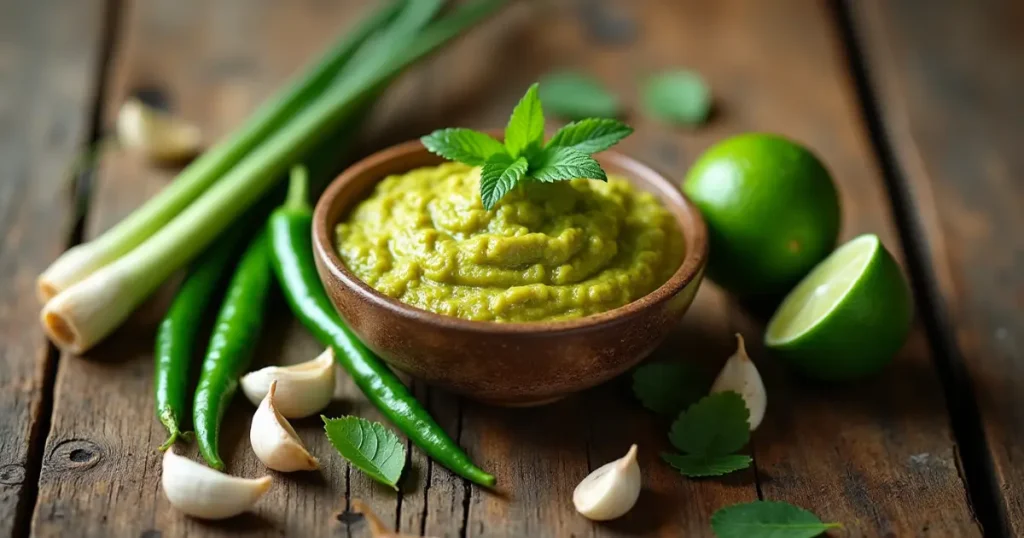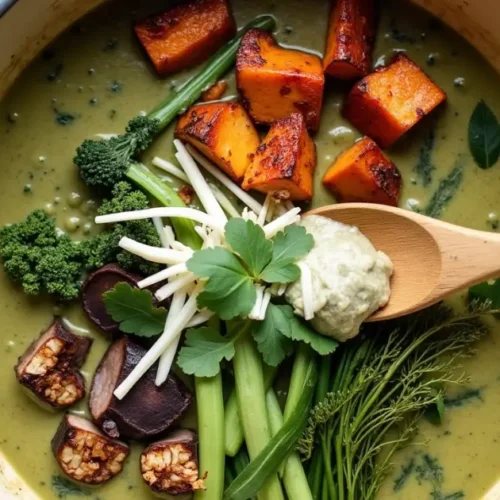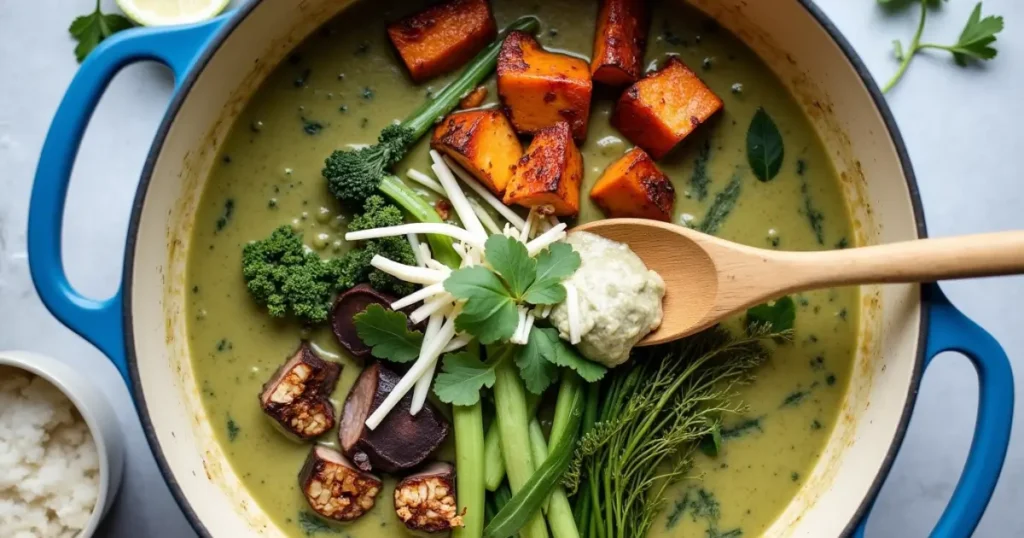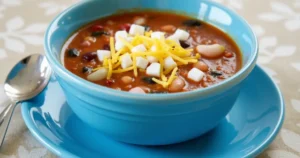Creating your own Thai green curry paste at home isn’t just rewarding, it’s a total flavor game-changer. Have you ever wondered why restaurant curries taste so rich and vibrant compared to store-bought sauces? Well, today you’re about to discover the secret behind that irresistible magic.
This special recipe, crafted by Chef Luna, a world-class culinary expert with decades of global kitchen experience, brings you a beautifully simple yet authentic approach to mastering the best Thai green curry paste right in your own kitchen. Whether you’re chasing the bold heat of a traditional green curry paste recipe or seeking a lighter twist like a vegetarian Thai green curry paste recipe, this guide has something delicious for you.
Chef Luna believes that great cooking starts with fresh, quality ingredients and a little bit of heart. That’s why she’s blending classic Thai techniques with modern shortcuts think traditional mortar and pestle or quick whirls in a food processor. Plus, if you’re curious about fusion cooking, we’ll even sprinkle in a unique nod to the popular brazilian mounjaro recipe trend, showing how a simple 3 ingredient Brazilian mounjaro can inspire your next curry masterpiece.
Get ready to experience a Homemade Thai Green Curry Paste that’s fresher, healthier, and endlessly customizable. By the end of this recipe, you’ll not only have a stunning paste but a deeper love for Thai flavors and a few creative tricks up your sleeve too.
Let’s dive into the aromatic world of Thai cuisine, hand in hand with Chef Luna, and discover just how amazing your own curry paste can be.
Key Benefits of Making Thai Green Curry Paste at Home
There’s something magical about making your own Thai green curry paste from scratch. It’s not just about the bold flavors; it’s about the connection you build with the ingredients and the satisfaction you feel when your curry sings with authentic, vibrant taste. If you’ve ever settled for store-bought paste and felt something was missing, you’re definitely in the right place today.
Table of Contents
Let’s dive into why creating your own homemade Thai green curry paste is truly worth it, with a few tips from world-class culinary expert, Chef Luna.
Why You’ll Love Making Your Own Thai Green Curry Paste
Making it yourself unlocks a whole new level of freshness and flavor that pre-packaged versions simply can’t touch. Here are the key reasons why:
1. Freshness and Authenticity
- Fresh herbs and spices, like kaffir lime leaves and lemongrass, release natural oils that are often lost in processed pastes.
- You can adjust the flavors exactly to your liking—spicier, zestier, or a little more herbal depending on your mood.
2. Healthier Ingredients

- No preservatives, excess sodium, or artificial flavors.
- Perfect for crafting a vegetarian Thai green curry paste recipe or even a fully vegan version if you skip shrimp paste.
3. Full Creative Control
- Want a smoky flavor? Roast your chilies first.
- Love extra heat? Toss in a few more green chilies.
- Curious about fusions? Borrow inspiration from the vibrant Brazilian Mounjaro recipe trend to add a fun twist.
4. Cost-Effective
- A small batch of homemade Thai green curry paste costs a fraction of gourmet store versions and can be frozen for months.
5. Versatility Beyond Curries
- Use your green curry paste as a marinade, soup base, or even to spice up stir-fries and roasted veggies.
Comparison Table: Homemade vs. Store-Bought Thai Green Curry Paste
| Feature | Homemade Paste (Chef Luna’s Style) | Store-Bought Paste |
| Freshness | Unmatched, made with real herbs | Often muted, processed |
| Ingredients Control | 100% customizable | Fixed, often preservative-laden |
| Flavor Profile | Bold, aromatic, authentic | Sometimes flat or too salty |
| Health Benefits | No additives, natural oils | May contain additives |
| Cost Efficiency | Budget-friendly in the long run | Higher per serving |
Chef Luna’s Tips for Maximum Flavor
When Chef Luna creates her famous green curry paste recipes, she swears by a few golden rules:
- Always toast spices lightly before blending to bring out their essential oils.
- Use a mortar and pestle if time allows; it creates a richer, more complex texture compared to a food processor.
- Keep it balanced: if your paste feels too spicy, balance it with a hint of coconut sugar or more kaffir lime.
By crafting your own best Thai green curry paste, you’re not just making a condiment you’re elevating every dish it touches. As we move forward, you’ll see just how easy it is to pull together this incredible paste with a few simple, vibrant ingredients.
Essential Ingredients for the Best Thai Green Curry Paste
Now that you know the magic homemade Thai green curry paste can bring, it’s time to gather everything you’ll need. According to Chef Luna, the beauty of crafting this paste lies in using fresh, vibrant ingredients that work together in perfect harmony.
Whether you’re making a classic version or adjusting for a vegetarian Thai green curry paste recipe, each ingredient plays a key role in building those deep, authentic flavors.
Must-Have Ingredients for Authentic Flavor
Here’s what you’ll want to have on hand:
| Ingredient | Purpose | Notes |
| Fresh green chilies | Heat and vibrant color | Thai bird’s eye chilies preferred |
| Lemongrass stalks | Citrusy freshness | Use only the tender inner parts |
| Kaffir lime leaves or zest | Bold, fragrant citrus aroma | Fresh is best, dried can substitute |
| Galangal root | Earthy, peppery depth | Ginger can be a backup if unavailable |
| Shallots | Mild, sweet onion flavor | Red shallots give richer taste |
| Garlic cloves | Rich aromatic base | Fresh cloves, not pre-minced |
| Coriander seeds | Warm, nutty base flavor | Toast lightly before use |
| Cumin seeds | Deep, smoky warmth | Boosts earthiness |
| White peppercorns | Gentle heat | Substitute with black if needed |
| Shrimp paste (optional) | Traditional umami punch | Omit for vegetarian version |
| Sea salt | Enhances all flavors | Fine sea salt recommended |
Chef Luna recommends always sourcing the freshest herbs and spices you can find they’ll make all the difference between a good curry and a show-stopping one.
Optional Additions for Special Twists
If you’re feeling adventurous, these additions can enhance your homemade Thai green curry paste even more:
- Thai sweet basil leaves – Adds a sweeter, anise-like layer of flavor
- Turmeric root – Boosts color and earthy richness
- Fresh cilantro stems – For a herbaceous, vibrant bite
- Brazilian Mounjaro twist: For a creative spin inspired by the brazilian mounjaro recipe, you can blend in a small amount of cashews or peanuts for creaminess, keeping it close to the spirit of 3 ingredient Brazilian mounjaro simplicity.
Ingredient Tips from Chef Luna
Making the best Thai green curry paste comes down to respecting the ingredients. Here are Chef Luna’s personal ingredient tips:
- Use young lemongrass: It’s tender and blends easier.
- Choose smaller chilies: They tend to be spicier and more aromatic.
- Toast your seeds: Lightly toasting coriander and cumin before grinding unlocks their true depth.
- Skip the shrimp paste: For a vegetarian Thai green curry paste recipe, simply increase the salt slightly or add a splash of light soy sauce.
Gathering these ingredients is the first exciting step toward creating a paste that outshines anything you’ll find in a jar. Once you’ve assembled your flavorful lineup, you’re only a few simple steps away from a fresh, homemade Thai culinary treasure.
Step-by-Step Instructions for Homemade Thai Green Curry Paste
You’ve gathered your ingredients, and now it’s time to bring them to life. With Chef Luna’s expert guidance, making your own Thai green curry paste becomes an exciting, hands-on experience, full of rich aromas and vibrant colors.
Whether you choose the traditional method with a mortar and pestle or opt for the quicker food processor route, this recipe is designed to be approachable for everyone.
How to Make Thai Green Curry Paste
Follow these simple steps to create a paste that’s fresher and more flavorful than anything from a jar.
Step 1: Prep Your Ingredients
- Wash all herbs and vegetables thoroughly.
- Trim and chop lemongrass into fine slices (only the tender white part).
- Peel and finely slice galangal and garlic cloves.
- Remove seeds from chilies if you prefer a milder paste.
Chef Luna’s Tip:
The finer you chop your ingredients, the smoother your paste will turn out, especially if you’re using a mortar and pestle.
Step 2: Toast the Spices
- In a dry skillet over medium heat, toast the coriander seeds, cumin seeds, and peppercorns until fragrant (about 1–2 minutes).
- Let them cool slightly, then grind to a powder using a spice grinder or mortar.
| Spices to Toast | Approximate Amount |
| Coriander Seeds | 1 tablespoon |
| Cumin Seeds | 1 teaspoon |
| White Peppercorns | ½ teaspoon |
Chef Luna’s Tip:
Toasting unlocks the essential oils, enhancing the earthy undertones of your green curry paste recipe.
Step 3: Blend the Ingredients
You have two options depending on how traditional (or speedy) you want to be.
Traditional Method (Mortar and Pestle)
- Add salt to the mortar first it acts as an abrasive.
- Pound garlic, chilies, and lemongrass into a rough paste.
- Gradually add shallots, galangal, kaffir lime zest, and ground spices.
- Keep pounding until smooth and fragrant.
Modern Method (Food Processor)
- Place all ingredients into a food processor.
- Add a splash of water or neutral oil to help blend if needed.
- Pulse until a thick, smooth paste forms.
Chef Luna’s Tip:
Using a mortar and pestle gives a more complex texture and deeper flavor, but for busy days, a processor will still deliver a fantastic homemade Thai green curry paste.
Step 4: Adjust and Store
- Taste your paste and adjust seasoning as needed.
- Transfer to a clean jar, cover with a thin layer of oil to preserve freshness, and refrigerate.
- It can be stored for up to 2 weeks in the fridge or 3 months in the freezer.
| Storage Method | Duration |
| Refrigerator | Up to 2 weeks |
| Freezer | Up to 3 months |
Chef Luna’s Tip:
Freeze your paste in ice cube trays for quick and easy portioning when you’re ready to cook your next Thai masterpiece.
By following these steps, you’re not just making a condiment you’re creating a foundation for countless delicious meals. With your own homemade Thai green curry paste in hand, a world of vibrant dishes awaits you.
Are you ready to discover Chef Luna’s personal pro tips and creative variations next?
Pro Tips and Creative Variations for Thai Green Curry Paste

Mastering a beautiful Thai green curry paste is just the beginning. Once you’ve got the basics down, there are endless ways to personalize your paste for different moods, dishes, and dietary needs. Chef Luna always encourages experimenting a little it’s where some of the best flavors are born.
Here’s how you can level up your homemade curry paste and put your own spin on it.
Pro Tips from Chef Luna for Next-Level Flavor
These small tweaks make a big impact on the final taste:
- Use Ice-Cold Water When Blending
Adding a splash of ice-cold water instead of room temperature helps preserve the vibrant green color of your paste. - Grind Longer Than You Think
Whether using a mortar or a processor, blend or pound until the paste releases natural oils. That’s the secret behind restaurant-quality green curries. - Balance Heat and Brightness
If your paste tastes too fiery, balance it with a touch more kaffir lime zest or a pinch of coconut sugar. - Layer the Paste During Cooking
When you cook, start by gently frying your curry paste in oil before adding other ingredients. It deepens the flavor beautifully. - Taste Raw Before Cooking
It sounds bold, but tasting a tiny bit of raw paste will help you adjust saltiness, sweetness, and heat before using it in dishes.
Creative Variations for Every Taste
Want to customize your paste for special diets or new flavor adventures? Here are some ideas:
Vegetarian Thai Green Curry Paste Recipe
- Omit shrimp paste completely.
- Add an extra clove of garlic and a teaspoon of light soy sauce for a deeper umami kick.
- Perfect for veggie-loaded curries or tofu stir-fries.
Brazilian Mounjaro Inspired Green Curry
- Add a small handful of roasted cashews during blending for a creamier texture, borrowing from the brazilian mounjaro recipe trend.
- This twist keeps your paste rich, nutty, and wonderfully unique.
| Variation Type | Key Adjustment | Best For |
| Vegetarian Version | Skip shrimp paste, add light soy sauce | Vegan and vegetarian curries |
| Extra Spicy Version | Double the green chilies | Heat lovers |
| Mounjaro-Inspired Twist | Blend in roasted cashews | Creamy, fusion curries |
| Herb-Forward Variation | Add extra Thai basil and cilantro stems | Fresh, lighter dishes |
Chef Luna’s Favorite Secret Add-Ins
Looking to impress even more? Here are a few favorite secret ingredients that Chef Luna uses when she wants her green curry paste to really shine:
- Fresh turmeric: Adds a golden hue and a subtle earthy note.
- Thai basil stems: A pop of herbaceous sweetness.
- White miso: A vegetarian-friendly boost of umami when shrimp paste is omitted.
Adding any of these twists can create a signature curry paste that’s uniquely yours — one that family and friends will rave about.
By following these pro tips and trying a few variations, your homemade Thai green curry paste will evolve from excellent to absolutely unforgettable. Whether you stick to tradition or take a creative leap with a Brazilian mounjaro flair, every batch will reflect your personal touch and passion.
Delicious Ways to Serve Your Thai Green Curry Paste

Now that your Thai green curry paste is freshly prepared, the possibilities for using it are almost endless. From traditional Thai dishes to unexpected fusion ideas, Chef Luna has countless creative suggestions to make sure you get the most out of your homemade masterpiece.
Here’s how to turn that vibrant, flavorful paste into unforgettable meals.
Classic Thai Dishes to Make
These traditional recipes are where your paste truly shines:
- Green Curry Chicken
Simmer chicken, bamboo shoots, and eggplant in coconut milk with a few tablespoons of your homemade paste. - Vegetarian Thai Green Curry
Use tofu, mushrooms, and a mix of seasonal vegetables. This is perfect for showcasing your vegetarian Thai green curry paste recipe version. - Thai Green Curry Noodles
Stir a spoonful of curry paste into coconut milk, add cooked rice noodles, and top with fresh herbs for a quick, flavorful dinner. - Thai Green Curry Fried Rice
Sauté cooked rice with green curry paste, veggies, and your protein of choice for a spicy, savory meal.
Creative Fusion Ideas
Inspired by the adventurous spirit of Brazilian mounjaro recipes, here are a few fusion ideas Chef Luna recommends:
- Green Curry Mounjaro Wraps
Toss grilled chicken or tofu in green curry sauce and wrap it up in a soft flatbread with crunchy veggies. - Green Curry Tacos
Swap out traditional taco fillings with green curry-spiced shrimp or jackfruit for a bold, mouthwatering twist. - Curry-Spiced Roasted Vegetables
Mix green curry paste with olive oil, toss with vegetables, and roast for a flavorful side dish.
| Dish Idea | Perfect For |
| Green Curry Chicken | Traditional Thai meal night |
| Vegetarian Thai Green Curry | Meatless Mondays, vegan dinner |
| Curry Noodle Bowls | Quick weeknight comfort food |
| Brazilian Mounjaro Wraps | Fusion street food style meals |
| Green Curry Tacos | Bold and fun taco night |
| Spicy Curry Roasted Veggies | Easy side dishes, meal prepping |
Chef Luna’s Top Serving Tips
- Start with less paste when cooking and add more to taste. It’s easier to build flavor than to tone down too much heat.
- Bloom the paste by frying it briefly in oil before adding liquids like coconut milk; this releases deep, rich aromas.
- Garnish generously: Fresh Thai basil, cilantro, and a squeeze of lime over finished dishes bring out the green curry’s bright notes.
- Balance your flavors: If a dish feels too spicy, a splash of coconut milk or a sprinkle of palm sugar can bring it right back into harmony.
There’s no wrong way to use your best Thai green curry paste only endless opportunities to create something delicious. Thanks to Chef Luna’s expert tips and inspiration, your meals are about to get a whole lot more exciting, whether you’re sticking to authentic Thai traditions or experimenting with fusion favorites.
Conclusion – Unlock Endless Possibilities with Thai Green Curry Paste
Congratulations! You’ve now got everything you need to master the art of creating vibrant, flavorful Thai green curry paste at home. With the help of Chef Luna, you’ve learned not only how to make a truly authentic version but also how to adapt it to your taste and cooking style.
Crafting your own homemade Thai green curry paste means you control the ingredients, the spice level, and the freshness no more settling for jarred options that miss the magic.
What You’ve Achieved Today
Here’s a quick look at the skills you’ve picked up:
- Understanding key ingredients and how they build flavor.
- Mastering traditional and modern methods of paste preparation.
- Learning versatile ways to use your paste across different dishes.
- Customizing the recipe for dietary needs or creative fusion ideas like a brazilian mounjaro twist.
| Achievement | Benefit |
| Ingredient mastery | Fresher, more authentic flavors |
| Paste-making techniques | Traditional and quick options |
| Versatile applications | Curries, noodles, wraps, and more |
| Creative variations | Personalized to your taste |
Final Thoughts from Chef Luna
Making your own best Thai green curry paste is more than just another kitchen project; it’s an invitation to explore, to customize, and to connect with the rich culinary traditions of Thailand in a personal and meaningful way.
Chef Luna encourages you to keep experimenting maybe add an extra handful of basil one day, or blend in cashews for a Mounjaro-style creamy finish. With every batch, your skills and your flavors will grow.
So next time you think about reaching for a jar at the store, remember: in just a few steps, you can create something fresher, bolder, and truly unforgettable a beautiful paste made by your own hands.
Thank you for cooking along with Chef Luna today. Your culinary journey has only just begun.
FAQs About Thai Green Curry Paste
When it comes to making and using your own Thai green curry paste, a few questions always seem to pop up. Chef Luna has gathered the most common ones to make sure you feel confident every step of the way.
Let’s clear up any last bits of confusion with some helpful, practical answers.
How long can homemade Thai green curry paste be stored?
Homemade paste stores wonderfully with a little care. Here’s a quick storage guide:
| Storage Method | Best Practices | Shelf Life |
| Refrigerator | Store in an airtight jar, cover with oil | Up to 2 weeks |
| Freezer | Portion into ice cube trays, freeze solid | Up to 3 months |
Chef Luna’s Tip:
Always use a clean spoon to scoop out your paste to avoid contamination and extend freshness.
Can I make a vegetarian Thai green curry paste recipe?
Absolutely.
To create a vegetarian Thai green curry paste recipe, simply omit the shrimp paste and:
- Add a splash of light soy sauce or tamari for extra umami.
- Increase the garlic slightly for a deeper flavor base.
This version still delivers the bold, authentic taste you love and it’s vegan-friendly too!
What if I can’t find galangal or kaffir lime leaves?
Fresh galangal and kaffir lime leaves are iconic to true green curry paste recipes, but don’t worry if they’re tricky to find:
- Galangal Substitute: Fresh ginger (use slightly less and add a pinch of black pepper).
- Kaffir Lime Substitute: Regular lime zest works well, though use half the amount to avoid overpowering the flavor.
| Missing Ingredient | Easy Substitute | Adjustment Needed |
| Galangal | Fresh ginger + pinch of black pepper | Slightly less ginger |
| Kaffir lime leaves | Regular lime zest | Use half the amount |
Chef Luna’s Tip:
While substitutes work in a pinch, sourcing authentic Thai ingredients whenever possible will give you the most vibrant flavor.
Can I adjust the spice level in Thai green curry paste?
Yes, and it’s one of the best reasons to make your own paste!
- For a milder paste, remove the seeds from the chilies before blending.
- For a fiery kick, add extra green bird’s eye chilies or include a few spicy Thai dragon chilies.
Tuning the heat level means you can tailor every dish to your taste without sacrificing the wonderful complexity of your homemade best Thai green curry paste.
Is Thai green curry paste used for dishes other than curry?
Definitely.
One of the coolest things about homemade Thai green curry paste is its versatility. You can:
- Stir it into stir-fries for a spicy twist.
- Whisk it into coconut milk for creamy, bold sauces.
- Rub it onto meats or tofu before grilling.
- Mix it into dips or salad dressings for a Thai-flavored flair.
Chef Luna’s Tip:
Use a little creativity even roasted vegetables or grain bowls can get an exciting upgrade with a spoonful of this paste.
What is a Brazilian Mounjaro twist in green curry paste?
Drawing from the Brazilian Mounjaro recipe trend, a mounjaro twist in your curry paste involves:
- Blending a few roasted cashews or peanuts into the paste.
- Adding a creamy, nutty undertone to your traditional flavors.
It’s an easy way to bring richness and a subtle fusion vibe to your dishes without losing the soul of the original Thai green curry paste.
Answering these key questions wraps up your complete guide to mastering, customizing, and using Thai green curry paste. Thanks to Chef Luna’s expertise, you’re ready to explore even more delicious possibilities in your kitchen.

Thai Green Curry Paste: 7 Amazing Ways to Make It Better
Equipment
- Mortar and Pestle
- Food Processor
- Spice Grinder
Ingredients
Main Ingredients
- 10 green chilies Thai bird’s eye preferred, seeded for less heat
- 2 stalks lemongrass finely chopped, tender parts only
- 1 tablespoon galangal peeled and sliced
- 3 shallots peeled and chopped
- 5 cloves garlic peeled
- 1 teaspoon coriander seeds lightly toasted
- 1 teaspoon cumin seeds lightly toasted
- 1/2 teaspoon white peppercorns ground
- 1 teaspoon sea salt
- 1 tablespoon shrimp paste optional for traditional version
- 2 kaffir lime leaves or 1 teaspoon lime zest
Instructions
- Prepare all fresh ingredients by washing and finely chopping where needed.
- Toast coriander seeds, cumin seeds, and white peppercorns in a dry pan until fragrant, then grind into a powder.
- If using a mortar and pestle, pound the salt with garlic, chilies, and lemongrass first until smooth, then add shallots, galangal, lime leaves, and ground spices gradually.
- If using a food processor, combine all ingredients with a small splash of cold water and pulse until a smooth, thick paste forms.
- Taste and adjust seasoning if needed. Transfer paste to a clean jar, cover with a thin layer of oil, and refrigerate.




